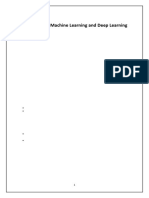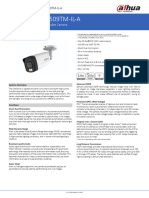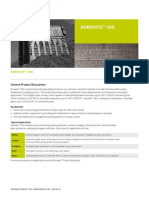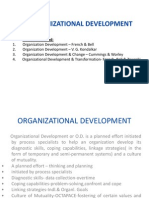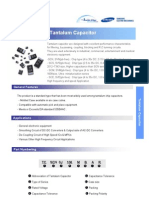ml_cheatsheet
Uploaded by
Lenaraml_cheatsheet
Uploaded by
LenaraMachine Learning Algorithms Cheat Sheet
Table of Contents
1. Supervised Learning
Linear Regression
Logistic Regression
Decision Trees
Random Forests
Support Vector Machines (SVM)
k-Nearest Neighbors (k-NN)
Naive Bayes
Gradient Boosting Machines (GBM)
Neural Networks
2. Unsupervised Learning
k-Means Clustering
Hierarchical Clustering
Principal Component Analysis (PCA)
Independent Component Analysis (ICA)
Association Rules
Autoencoders
3. Reinforcement Learning
Q-Learning
Deep Q-Networks (DQN)
Policy Gradients
Actor-Critic Methods
4. Semi-Supervised and Self-Supervised Learning
Self-Training
Co-Training
5. Ensemble Methods
Bagging
Boosting
Stacking
Supervised Learning
1. Linear Regression
Purpose: Predict continuous target variables.
Key Concept: Models the relationship between input features and output as a linear combination.
Equation: ( y = \beta_0 + \beta_1x_1 + \beta_2x_2 + \dots + \beta_nx_n + \epsilon )
2. Logistic Regression
Purpose: Binary classification.
Key Concept: Uses the logistic function to model the probability of a class.
Equation: ( P(Y=1) = \frac{1}{1 + e^{-(\beta_0 + \beta_1x_1 + \dots + \beta_nx_n)}} )
3. Decision Trees
Purpose: Classification and regression.
Key Concept: Splits data into subsets based on feature values.
Advantages: Easy to interpret, handles both numerical and categorical data.
Disadvantages: Prone to overfitting.
4. Random Forests
Purpose: Classification and regression.
Key Concept: Ensemble of decision trees using bagging.
Advantages: Reduces overfitting, handles large datasets well.
Key Parameters: Number of trees, max depth.
5. Support Vector Machines (SVM)
Purpose: Classification and regression.
Key Concept: Finds the hyperplane that best separates classes with maximum margin.
Kernel Trick: Enables handling non-linear relationships.
Common Kernels: Linear, Polynomial, RBF.
6. k-Nearest Neighbors (k-NN)
Purpose: Classification and regression.
Key Concept: Assigns the output based on the majority label of the k closest training examples.
Advantages: Simple, no training phase.
Disadvantages: Computationally intensive during prediction, sensitive to irrelevant features.
7. Naive Bayes
Purpose: Classification.
Key Concept: Based on Bayes' Theorem with the assumption of feature independence.
Variants: Gaussian, Multinomial, Bernoulli.
8. Gradient Boosting Machines (GBM)
Purpose: Classification and regression.
Key Concept: Builds models sequentially, each new model correcting errors of the previous ones.
Popular Implementations: XGBoost, LightGBM, CatBoost.
Advantages: High predictive performance, handles missing data.
9. Neural Networks
Purpose: Various tasks including classification, regression, and more.
Key Concept: Composed of layers of interconnected nodes (neurons) that can capture complex patterns.
Types: Feedforward Neural Networks, Convolutional Neural Networks (CNN), Recurrent Neural Networks (RNN).
Unsupervised Learning
1. k-Means Clustering
Purpose: Partition data into k distinct clusters.
Key Concept: Minimizes within-cluster variance.
Parameters: Number of clusters (k), distance metric.
2. Hierarchical Clustering
Purpose: Create a hierarchy of clusters.
Key Concept: Either agglomerative (bottom-up) or divisive (top-down).
Linkage Criteria: Single, complete, average, ward.
3. Principal Component Analysis (PCA)
Purpose: Dimensionality reduction.
Key Concept: Transforms data to a new coordinate system with orthogonal principal components.
Uses: Feature reduction, visualization.
4. Independent Component Analysis (ICA)
Purpose: Separate a multivariate signal into additive, independent components.
Key Concept: Maximizes statistical independence.
5. Association Rules
Purpose: Discover interesting relations between variables in large databases.
Key Concepts: Support, Confidence, Lift.
Algorithms: Apriori, Eclat.
6. Autoencoders
Purpose: Learn efficient codings of input data.
Key Concept: Neural network architecture with encoder and decoder parts.
Uses: Dimensionality reduction, anomaly detection.
Reinforcement Learning
1. Q-Learning
Purpose: Learn the value of actions in states to derive an optimal policy.
Key Concept: Off-policy temporal difference learning.
Equation: ( Q(s, a) \leftarrow Q(s, a) + \alpha [r + \gamma \max_{a'} Q(s', a') - Q(s, a)] )
2. Deep Q-Networks (DQN)
Purpose: Combine Q-Learning with deep neural networks.
Key Concept: Uses neural networks to approximate Q-values.
Features: Experience replay, target networks.
3. Policy Gradients
Purpose: Optimize the policy directly.
Key Concept: Uses gradient ascent on expected rewards.
Algorithms: REINFORCE, Proximal Policy Optimization (PPO).
4. Actor-Critic Methods
Purpose: Combine value-based and policy-based methods.
Key Concept: Actor updates policy, Critic evaluates it.
Examples: A3C, DDPG.
Semi-Supervised and Self-Supervised Learning
1. Self-Training
Purpose: Utilize unlabeled data to improve model performance.
Key Concept: Iteratively label unlabeled data using the current model.
2. Co-Training
Purpose: Use multiple views of data to train models.
Key Concept: Each model trains on different feature sets and labels unlabeled data for each other.
Ensemble Methods
1. Bagging (Bootstrap Aggregating)
Purpose: Reduce variance and prevent overfitting.
Key Concept: Train multiple models on different bootstrap samples and aggregate predictions.
Example: Random Forest.
2. Boosting
Purpose: Reduce bias and build strong predictive models.
Key Concept: Sequentially train models, each focusing on errors of the previous ones.
Examples: AdaBoost, Gradient Boosting, XGBoost.
3. Stacking
Purpose: Combine multiple models to improve performance.
Key Concept: Use a meta-model to aggregate predictions from base models.
Additional Algorithms and Techniques
Support Vector Regression (SVR)
Purpose: Regression using SVM principles.
Key Concept: Fits the best line within a predefined margin.
Elastic Net
Purpose: Regularized regression combining L1 and L2 penalties.
Key Concept: Balances between feature selection and coefficient shrinkage.
Gaussian Mixture Models (GMM)
Purpose: Probabilistic clustering.
Key Concept: Assumes data is generated from a mixture of several Gaussian distributions.
t-Distributed Stochastic Neighbor Embedding (t-SNE)
Purpose: Data visualization.
Key Concept: Reduces dimensions while preserving local structure.
Hidden Markov Models (HMM)
Purpose: Model sequential data.
Key Concept: States are hidden and emit observable events.
Key Concepts and Terms
Overfitting: Model performs well on training data but poorly on unseen data.
Underfitting: Model is too simple to capture underlying patterns.
Bias-Variance Tradeoff: Balance between model complexity and generalization.
Cross-Validation: Technique to assess model performance by partitioning data.
Regularization: Techniques to prevent overfitting (e.g., L1, L2).
Feature Scaling: Standardizing features to improve model performance.
Resources and Libraries
Python Libraries:
Scikit-learn: Comprehensive ML algorithms.
TensorFlow & Keras: Deep learning frameworks.
PyTorch: Flexible deep learning library.
XGBoost, LightGBM, CatBoost: Gradient boosting implementations.
Books:
"Hands-On Machine Learning with Scikit-Learn, Keras, and TensorFlow" by Aurélien Géron
"Pattern Recognition and Machine Learning" by Christopher M. Bishop
"The Elements of Statistical Learning" by Trevor Hastie, Robert Tibshirani, and Jerome Friedman
Online Courses:
Coursera's Machine Learning by Andrew Ng
edX's MicroMasters in Statistics and Data Science
Udacity's Machine Learning Nanodegree
You might also like
- Lecture Notes on Machine Learning Concepts.docxNo ratings yetLecture Notes on Machine Learning Concepts.docx5 pages
- Supervised Learning Final With Diagrams CleanedNo ratings yetSupervised Learning Final With Diagrams Cleaned7 pages
- ML_7th_Sem_AIML_ITE_Notes_Complete_LONG[1]-10-33No ratings yetML_7th_Sem_AIML_ITE_Notes_Complete_LONG[1]-10-3324 pages
- UCS_401_Unit-LV_ Trends in Machine Learning_Model and Symbols- Bagging and Boosting, MultitaskNo ratings yetUCS_401_Unit-LV_ Trends in Machine Learning_Model and Symbols- Bagging and Boosting, Multitask44 pages
- CP Presentation Affan, Hammad, Arman, ShayanNo ratings yetCP Presentation Affan, Hammad, Arman, Shayan18 pages
- What Are The Common Algorithms in Machine LearningNo ratings yetWhat Are The Common Algorithms in Machine Learning3 pages
- Kenny-230718-The Ultimate Machine Learning Cheat SheetNo ratings yetKenny-230718-The Ultimate Machine Learning Cheat Sheet20 pages
- Introduction To Machine Learning PPT MainNo ratings yetIntroduction To Machine Learning PPT Main15 pages
- book of 843_AI_Student_HandbookXI-104-127No ratings yetbook of 843_AI_Student_HandbookXI-104-12724 pages
- Machine Learning: A Comprehensive OverviewNo ratings yetMachine Learning: A Comprehensive Overview3 pages
- ITA6016 - Machine Learning IntroductionNo ratings yetITA6016 - Machine Learning Introduction13 pages
- Handout - BITS-F464 - Machine - Learning - August 2019No ratings yetHandout - BITS-F464 - Machine - Learning - August 20194 pages
- All Machine Learning Algorithms Explained in One LineNo ratings yetAll Machine Learning Algorithms Explained in One Line12 pages
- Lecture 01 Introducing ML 13102022 031101pmNo ratings yetLecture 01 Introducing ML 13102022 031101pm36 pages
- DATA MINING and MACHINE LEARNING: CLUSTER ANALYSIS and kNN CLASSIFIERS. Examples with MATLABFrom EverandDATA MINING and MACHINE LEARNING: CLUSTER ANALYSIS and kNN CLASSIFIERS. Examples with MATLABNo ratings yet
- AI for Everyone: An Intermediate Guide to Artificial IntelligenceFrom EverandAI for Everyone: An Intermediate Guide to Artificial IntelligenceNo ratings yet
- IMSLP890186-SIBLEY1802 20835 642e-39087012336113piecesNo ratings yetIMSLP890186-SIBLEY1802 20835 642e-39087012336113pieces50 pages
- Achieving Lean Data Science Agility Via Data Driven ScrumNo ratings yetAchieving Lean Data Science Agility Via Data Driven Scrum10 pages
- Yellow Gray and Black Minimalist Industries PresentationNo ratings yetYellow Gray and Black Minimalist Industries Presentation72 pages
- HDPE Pipe - Time Estimate, Methods, Cost Comparison - EDDY PumpNo ratings yetHDPE Pipe - Time Estimate, Methods, Cost Comparison - EDDY Pump8 pages
- Important Computer Awareness Quiz MCQ PDF For All Competitive ExamsNo ratings yetImportant Computer Awareness Quiz MCQ PDF For All Competitive Exams81 pages
- 11 Distribution System Load Characteristics (1172)No ratings yet11 Distribution System Load Characteristics (1172)9 pages
- Effect of Rainfall On Stability of Soil SlopeNo ratings yetEffect of Rainfall On Stability of Soil Slope6 pages
- Organizational Development: Books To Be ReadNo ratings yetOrganizational Development: Books To Be Read49 pages
- Diplomacy MSIA 710 Jan-June Intake CourseworkNo ratings yetDiplomacy MSIA 710 Jan-June Intake Coursework2 pages
- Question Bank for Communicative English BENGK10650% (4)Question Bank for Communicative English BENGK10626 pages
- CW Elvee - Keyfob Monitoring 2023 - AF Citywalk Elvee UPDATEDNo ratings yetCW Elvee - Keyfob Monitoring 2023 - AF Citywalk Elvee UPDATED14 pages
- CIS Amazon Web Services Foundations Benchmark v1.3.0 DRAFT 24JUL20No ratings yetCIS Amazon Web Services Foundations Benchmark v1.3.0 DRAFT 24JUL20192 pages
- Converting Steel Weldments To Ductile Iron CastingsNo ratings yetConverting Steel Weldments To Ductile Iron Castings5 pages
- Gcse Sets: Exercise 1 - Constructing Venn DiagramsNo ratings yetGcse Sets: Exercise 1 - Constructing Venn Diagrams5 pages
- Linux in Action David Clinton pdf download100% (1)Linux in Action David Clinton pdf download34 pages
- Instant ebooks textbook Fundamentals of Spatial Analysis and Modelling 1st Edition Jay Gao download all chapters100% (4)Instant ebooks textbook Fundamentals of Spatial Analysis and Modelling 1st Edition Jay Gao download all chapters37 pages
- 131_PDFsam_Essential Grammar in Use 4th Edition by R. MurphyNo ratings yet131_PDFsam_Essential Grammar in Use 4th Edition by R. Murphy2 pages













